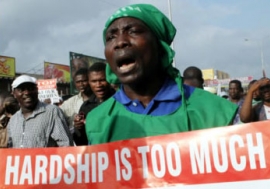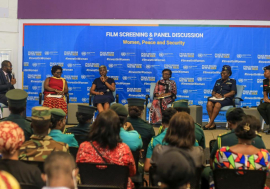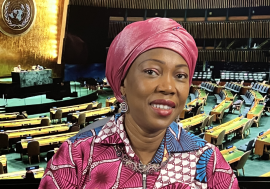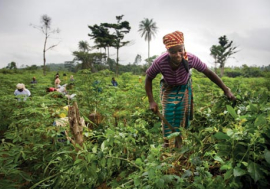Reintegration of ex-combatants
Reintegration of ex-combatants
Haja Sheriff wants to be a farmer. Like several hundred other former soldiers at the Duport Road agricultural training site on the edge of Monrovia, Liberia’s capital, she hopes to get a piece of land on which she can grow rice and vegetables and possibly raise goats, chickens or pigs.
Just a couple of years ago, Ms. Sheriff was a volunteer with a pro-government militia during the country’s recent civil war, she told Africa Renewal. But now she is learning new skills alongside the former rebels she once fought. A beneficiary of the disarmament and demobilization operation carried out by the UN Mission in Liberia (UNMIL), she is just finishing an eight-month reintegration course run by a local civil society organization, the Association for Development Aid.
Ms. Sheriff’s hopes are similar to those of hundreds of thousands of other ex-combatants across Africa. With the number of peace agreements increasing, more and more former soldiers and rebels are taking part in disarmament, demobili-zation and reintegration programmes — “DDR,” as the process is commonly known. They would like nothing better than to put violence behind them. They want to build new, productive lives for themselves, their families and their communities.
For many, giving up their guns was an easy first step. So was leaving their military faction. Successfully reentering civilian life — in countries still suffering war’s political, economic and social after-effects — may not be so simple. DDR programmes across Africa show that reintegration is a complex and long-term process. It is fraught with difficulties and depends on the success of wider efforts at economic recovery and political reconciliation.
Stuck in limbo
In neighbouring Sierra Leone, where a decade-long civil war ended in 2001, tens of thousands of ex-fighters have already made the transition to civilian life and are working as carpenters, cocoa farmers, small-scale traders and electricians.
But unemployment remains very high, especially among young people. The country’s school system is still struggling to recover. As a result, some ex-fighters are stuck in limbo:
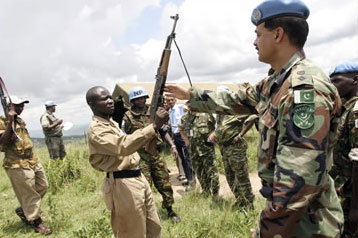 Disarmament in Burundi: With more peace pacts across Africa, hundreds of thousands of fighters are demobilizing.
Disarmament in Burundi: With more peace pacts across Africa, hundreds of thousands of fighters are demobilizing.- Momoh Koroma, who was abducted into the Revolutionary United Front (RUF) at the age of 16, received two months of vocational training as an auto mechanic following his demobilization. He is now “doing nothing,” he says.
- Abdul Kamara — once known as “Black Jesus” for his military exploits with the Armed Forces Revolutionary Council (AFRC) — got three months of electrical training and now scrapes by with odd jobs.
- Mohamed Karim Kanu, abducted 10 years ago into the AFRC at the age of 11, just wants to go back to school. But the whereabouts of his family is unknown and a non-governmental organization to which he was assigned after demobilization did not have the money to help him. So he is not in school and survives by “begging around the neighbourhood.”
These young men, like four other unemployed ex-combatants who met with Africa Renewal in Freetown, expressed no desire to again pick up a gun. But without a means of living or solid ties with local communities, many young Sierra Leoneans like them could be susceptible to recruitment by criminal gangs or future armed factions. “If what’s happening now continues, Sierra Leone will face another doomsday,” remarks Mr. Ibrahim Bangura, a child-protection officer with a local civil society group, the Post-Conflict Reintegration Initiative for Development and Empowerment (PRIDE), which is trying to help the youths.
A new phase
How to improve African DDR programmes was the central question on the minds of participants at a conference in Freetown on 21-23 June. “Without a comprehensive DDR programme, the prospects for long-term stability will remain dim,” President Ahmad Tejan Kabbah of Sierra Leone told the opening of the Conference on Disarmament, Demobilization, Reintegration and Stability in Africa . “All post-conflict programmes — be they political, social or economic — depend on DDR and how people judge its success.”
The meeting was organized by the government of Sierra Leone and the UN Office of the Special Adviser on Africa (OSAA). It brought together DDR experts and stakeholders from 15 African countries and a number of UN, donor and other international agencies. They shared experiences and ideas about ways to strengthen the design and functioning of such programmes. They agreed that DDR efforts are now entering a “new phase,” in which mandates should be defined more precisely and the perspectives of African practitioners and beneficiaries should be more central.
Among many other recommendations, participants cited the need for:
- Explicit provision for DDR in peace agreements
- Addressing the specific needs of women ex-combatants (see page 17)
- Better coordination among governments and peacekeeping forces in neighbouring countries to deal with cross-border movements of fighters and arms
- More attention to small-arms collection after the completion of formal disarmament operations
- Greater coordination among international partners, to help build national DDR capacities and ensure more flexible and timely financing.
Participants felt that while there is still room for improvement in the disarmament and demobilization phases, more attention, energies and resources should be devoted specifically to reintegration. DDR should not be just “DD plus R,” with reintegration as an afterthought, but a continuous, integrated process, argued Mr. Francis Kai-Kai, who headed Sierra Leone’s national DDR committee. “You don’t just focus on men and weapons, but on their futures as well.”
Reintegration must take a more central place, in part because successfully absorbing former combatants into civilian society takes longer than their disarmament and demobilization. Moreover, DD can be funded relatively quickly when a UN peace mission is involved, through the UN’s peacekeeping budget. But reintegration generally depends on voluntary contributions from a variety of multilateral, bilateral and national institutions, which often are not well coordinated and take time to begin delivering. As a result, financing has often been insufficient or late, contributing to lapses in vocational training and spreading disillusionment among ex-combatants.
There is another obstacle to financing DDR: Some donor agencies and civil society groups are reluctant to help anyone who has carried a gun. They worry that such assistance could be viewed as “rewarding” perpetrators of violence. However, argued Mr. Bengt Ljungren of the UN Development Programme (UNDP) in Sierra Leone, it is important for potential funders to realize that “most combatants are also victims,” especially the young fighters who were “misused” by the political instigators of violence.
 Ex-fighters learning garment- making in Liberia: New skills are essential for returning to civilian life.
Ex-fighters learning garment- making in Liberia: New skills are essential for returning to civilian life.Variations on a theme
The Freetown discussions revealed wide variations in DDR experiences in Africa. The relative ease and success of such operations have been strongly influenced by the nature of the peace settlement, the “political will” of its signers and the capacities of the government, UN and other institutions.
In a few countries, especially where only regular armies have been involved, demobilization has been relatively straightforward. In Eritrea, for example, 100,000 troops were demobilized following a peace agreement with neighbouring Ethiopia in December 2000. Those soldiers’ social reintegration went fairly smoothly, in part because most Eritreans view them as “national heroes,” explained Mr. Kaleab Haile, from the country’s demobilization and reintegration commission.
The dynamics are different where opposing armies faced off within the same country. There, the challenge has been orienting soldiers away from warfare and towards peaceful political activity. In Mozambique, often cited as an early DDR success, the government and the rebel Mozambique National Resistance (Renamo) signed a peace accord in 1992. Renamo demobilized and subsequently took part in national elections.
In Sierra Leone, the rebel RUF initially failed to adhere to peace agreements it signed, so few took part in DDR in the 1990s. But after the group suffered serious military reverses, the rebels agreed to disarm. A survey of 1,000 ex-combatants conducted in 2004 by US researchers working with PRIDE found no support for resuming armed action, including among former RUF fighters. While many expressed dissatisfaction with conditions in Sierra Leone, the vast majority saw their factions “as organizations from the past.”
Angola experienced a similar evolution. After a decade and a half of civil war, a peace agreement was signed in 1991. But only a small portion of the UNITA rebels actually demobilized and fighting resumed. Eventually the Angolan army made major advances, which culminated in February 2002 in the death of the UNITA leader. This opened the way to a new agreement and over a period of eight months the bulk of UNITA demobilized, with some troops being incorporated into the regular army.
In Liberia, after the failure of numerous earlier accords, the road to peace was unblocked when President Charles Taylor agreed to leave the country in 2003. A coalition government was established that included representatives of Mr. Taylor’s party and two rebel factions. The UN peacekeeping mission, UNMIL, oversaw disarmament and demobilization, which ended in December 2004.
At the Freetown conference, Mr. Moses Jarbo, the executive director of Liberia’s national DDR commission, accused the UN of marginalizing the national government. While many other participants agreed that DDR processes in general should try to reflect greater national “ownership,” they also realized that the capacity and credibility of the government can be a crucial factor.
According to Mr. Charles Achodo, a UNDP adviser on DDR with experience in both countries, “In Sierra Leone, you had a legitimate government on the ground. That put the government in a very strong position, where they could partner with the United Nations in doing the process.” However, in Liberia, the government is an unelected transitional entity, pending the installation of an elected government, probably in January 2006. It therefore has limited legitimacy. Also, because the government is fractious, Mr. Achodo told Africa Renewal, “it lacked the political will to drive the DDR process.” The UN Security Council, “in its wisdom,” therefore gave UNMIL the central mandate to implement DDR.
‘Plan B’ syndrome
Peace settlements in some countries have not been definitive or comprehensive, with some groups reluctant to fully abandon the option of armed struggle.
Zimbabwe’s General Sibusiso Moyo, now retired, recalled that in a peace accord 25 years ago, the Zimbabwean nationalist movements fighting the white minority Rhodesian regime agreed to demobilize and take part in national elections. But they did not fully trust the outcome. So they kept certain contingents and heavy armaments in reserve, a “Plan B” in case the war resumed. Participants in the Freetown conference recognized that the “Plan B” syndrome is a common one in Africa.
“All post-conflict programmes — be they political, social or economic — depend on DDR and how people judge its success.”
— President Ahmad Tejan Kabbah, Sierra Leone
In Côte d’Ivoire, the government and insurgent groups signed a peace accord in 2003, but they have been so mistrustful of each other that DDR has not even begun.
In the Democratic Republic of the Congo (DRC), explains Mr. Daniel Kawata, national coordinator of the DDR commission, about 10 armed groups signed the 1999 peace agreement, which established a transitional coalition government. Several militia groups, based mainly in the Ituri region, did not sign the accord, but 14,000 Ituri militia members have nevertheless joined the disarmament process.
Burundi’s peace effort has also been marked by a “phased” approach, notes Mr. Isaie Nibizi, head of the national demobilization and reintegration commission. The peace agreement in 2000 involved mainly political parties, while most — but not all — of the insurgent groups only began to sign on three years later. Formal DDR started in December 2004, with the goal of demobilizing 85,000 fighters by 2008. By June 2005 about 10,000 had demobilized. There are hopes that at least some of the last non-signers will also agree to demobilize in the wake of the August 2005 electoral victory of the largest former rebel group and the assumption of the presidency by its leader, Mr. Pierre Nkurunziza.
Justice now — or later?
In several of Africa’s wars, some of the factions were responsible for horrendous atrocities against civilians. In Rwanda, Sierra Leone and other countries, a number of suspected war criminals have been tried before local courts or international tribunals. But if large numbers of commanders and ordinary soldiers believe they will be immediately arrested, they may simply decide to keep their guns.
It has therefore been common for peace agreements to include amnesty provisions, as an incentive to join the peace process. The 1992 peace accord in Mozambique, for example, contained a blanket amnesty for everyone, on all sides.
A 1999 peace accord in Sierra Leone included a similar blanket amnesty. But given the scale of the war crimes there, the UN declared that it would not be bound by the amnesty provision. Subsequently, a UN-backed Special Court for Sierra Leone was established, which has been trying those bearing “the greatest responsibility” for violations of international human-rights laws, including leaders of the various armed factions. The court has also issued an indictment against former President Taylor of Liberia, for his role in supporting the RUF.
In Uganda, an amnesty commission is extending immunity from prosecution to any insurgent who agrees to demobilize and reintegrate. Justice Peter Onega, head of the commission, points out that most of these fighters were originally abducted as children by the rebel Lord’s Resistance Army (LRA). The International Criminal Court at The Hague has opened an investigation into LRA war crimes. But local communities sent a delegation to The Hague to argue that such action now could hamper Uganda’s current peace efforts, including the return of their children. Observes Justice Onega: “The people are saying: This is not the right time to talk of justice.”
For Mr. Kawata of the Congolese DDR commission, the solution is to separate the worst offenders from the mass of fighters. “During the disarmament, we don’t leave the heavy cases out,” he told Africa Renewal. “If they were involved in heavy criminal business, then they need to be arrested.” But the bulk are taken through the demobilization process. If some of them were involved in abuses, “we leave those cases until afterwards,” he says. If too many are arrested right away, “we lose the possibility of demobilizing a whole bunch of them.”
Done carefully, the combination of selective prosecutions with immunity for most rank-and-file fighters can eventually win over sceptics among the ex-combatants. A survey of former RUF fighters in the Sierra Leonean town of Makeni found that many wanted their former commanders to be held accountable and believed the Special Court would bring justice.
Cash, skills, tools
Some peace agreements include provisions for absorbing a portion of the former antagonists into restructured armed forces. Other ex-fighters simply go home after handing in their arms and uniforms, especially if they have families, farms and occupations waiting for them. For example, Mr. António Gaspar, who demobilized from the Mozambican government army in the early 1990s, had a higher education and was easily able to find a teaching position at the country’s Centre for Strategic and International Studies.
But most of his army colleagues, Mr. Gaspar told Africa Renewal, had a much harder time. They were more typical of Africa’s demobilized ex-combatants, with limited education and few skills other than fighting. For them, the most attractive incentive for taking part in DDR is the possibility of gaining some tangible help in making the transition to civilian life: several months of financial payments, tuition to go to school, a chance to learn new job skills and start-up kits for farming or small businesses.
In Liberia, about 40 per cent of the demobilized fighters said they wanted to go back to school. Most of the rest indicated a preference for vocational training, with auto mechanics the most popular choice among men and tailoring among women.
For those ex-fighters who manage to complete their schooling or vocational training, the future is not necessarily assured. Will there be jobs or other income opportunities?
About 300 former combatants are attending daily classes at the Liberia Opportunities Industriali-zation Centre (LOIC) in Sinkor, Monrovia. During a visit in late June, sessions were under way in garment-making, plumbing and woodworking. Student electricians were busy taking an exam. The centre also offers courses in small-business management, while six other LOIC centres in rural counties focus on agriculture for another 1,000 students.
“Because many of them cannot read or write,” explains Mr. George Kpawulu, the LOIC’s national executive director, “we also give them pre-vocational numeracy and literacy.” In addition, he says, counselors are on hand to help with problems related to war trauma.
Mr. Solomon King, the LOIC director, notes that the students include former members of all the main warring factions, but they are encouraged to forget past allegiances and focus on working together. “They get along fine. They are young Liberians with hope for the future.”
‘A very fast pace’
Those in the LOIC courses are among the fortunate ones. So far, there are not enough reintegration projects for all who want them.
According to Mr. Nisar Malik of UNMIL’s Special Operations Division, the gap results from the size and speed of demobilization. Initially, DDR planners expected only some 38,000 fighters, and financing for reintegration and rehabilitation (RR) was arranged with donors accordingly. But that figure proved highly inaccurate. “The faction leaders,” Mr. Malik said, “did not come forward with realistic lists.” So when the numbers eventually swelled to more than 100,000, not enough money was immediately available. “The DD programme went very fast,” concluded Mr. Malik, “and the RR was very slow.”
Mr. Achodo, UNDP’s DDR adviser in Liberia, adds that the numbers of demobilized were also high because of loose eligibility criteria. In part, those criteria stemmed from earlier criticisms that Sierra Leone’s programme had excluded combatants who did not possess a weapon to hand over, especially women. So the Liberian operation accepted anyone who had either a weapon or ammunition and took in female and child combatants who had neither. That brought in more women, but also men who may not have been combatants but had managed to acquire arms or ammunition. Mr. Achodo holds up a report showing that about 22,000 males classified as “other” — not affiliated with any of the main factions — were allowed in. When that trend was first noticed, he says, the criteria should have been narrowed to focus mainly on women and child combatants. “We didn’t revise the eligibility criteria as quickly as we should have,” he concedes. “We ran at a very fast pace. We didn’t have time for reflection.”
Because of the surge in numbers, some 26,000 demobilized Liberians still had not begun receiving reintegration assistance as of August 2005. In a report to the Security Council the following month, UN Secretary-General Kofi Annan warned that since the overall security situation was “calm, yet fragile,” the shortfall in donor funding for reintegration could cause problems. “The ex-combatants are a volatile group,” he noted.
What future for ‘graduates’?
For those ex-fighters who manage to complete their schooling or vocational training, the future is not necessarily assured. Will there be jobs or other income opportunities? Most post-war economies remain exceptionally weak. Employment is limited, and few people can afford the services of the newly trained carpenters, auto mechanics or plumbers. As one demobilized Mozambican soldier put it, they were “reintegrated back into basic poverty.”
 Tensions at a Liberian cantonment site: “Ex-combatants are a volatile group,” notes UN Secretary-General Kofi Annan.
Tensions at a Liberian cantonment site: “Ex-combatants are a volatile group,” notes UN Secretary-General Kofi Annan.Sierra Leone’s experience provides some grounds for hope — along with a note of caution. A large number of ex-combatants there were able to acquire some form of livelihood, however limited. There is some indication that those who went into farming may have done better than graduates of vocational training programmes.
According to Mr. Ibrahim Sarpee, a programme officer with the non-governmental Friends of Africa Relief and Development Agency, the group helped register about 100 ex-RUF fighters in Kailahun, on Sierra Leone’s eastern border. Seventy-three of them went into tree-crop farming, and “they’re doing well,” Mr. Sarpee reports. The rest received training in soap making, tailoring and other occupations. “They’re now skilled, but there’s no employment.”
In Liberia, the 500 ex-combatants at the Duport Road project and the more than 1,000 in the LOIC’s six rural centres reflect some interest in farming. “Liberia is an agricultural nation,” stresses Mr. Kpawulu. “We have vast lands, underutilized. We are unable to feed ourselves. So it is better to conscientize the young people to learn to farm.”
At Duport Road, the young ex-fighters raised concerns about access to land once they return to their home areas. Project officials assured them that local village chiefs had already identified land for their use.
Whatever has been arranged for these particular ex-fighters, the issue of land is not a simple one, in either Liberia or Sierra Leone. In both countries, young people and women have traditionally been bypassed when village elders allocate community-owned lands. Such lack of access to land was one of the grievances that impelled many young people to join the armed groups in the first place.
In Liberia’s Nimba and Lofa counties, there already have been renewed land tensions between members of local ethnic groups and Mandingos, who are viewed as “outsiders” and therefore not entitled to land. Since many Mandingos supported the Liberians United for Reconciliation and Democracy (LURD), the strongest of the former rebel groups, such conflicts could ultimately jeopardize the overall peace process.
Into the communities
Because of their specific mandates, most DDR programmes concentrate on ex-combatants, and less on the communities to which they will return. This has elicited some criticism that current reintegration efforts are too narrow and should do more to help broader community recovery.
Ms. Béatrice Pouligny, a senior researcher at the Centre d’études et de recherches internationales (CERI) in France , argues that an “approach which focuses on ‘individual’ incentives may miss the broader ‘collective’ dimension.” Ex-combatants “cannot be considered without taking their families and social ties into account.” She recommends “the broadening of the DDR framework” to include such factors.
She and others have stressed the benefits of a community approach: less resentment that demobilized soldiers may be receiving “privileges” denied to others, joint projects that can help rebuild trust and greater social controls over the behaviour of former combatants.
Most DDR experts and practitioners agree that war-ravaged communities require more support, both for their own sake and to help ensure that ex-fighters are able to successfully reintegrate over the long term. As Mr. David Munyurangabo of Rwanda’s DDR commission acknowledged at the Freetown conference, “Civilians should also benefit,” a view echoed by many other participants.
Some DDR programmes have incorporated community aspects. In the Central African Republic, for example, the UNDP and World Bank have provided $3.3 mn for a reintegration project that includes rehabilitating community infrastructure and creating income-generating activities.
Mr. Steven Ursino, UNDP’s Liberia country director, told Africa Renewal that the reintegration of ex-combatants there is taking place “in a wider context” that includes the return of thousands of refugees and displaced people and the rehabilitation of communities destroyed by 14 years of war. At the Duport Road reintegration site, about 100 local farmers joined the 500 ex-combatants. They did not receive the same cash payments, but they were able to learn new farming techniques and skills.
In a certain sense, funds allocated specifically for ex-fighters ultimately benefit local communities, notes Mr. Achodo. Out of every dollar he spends in Liberia, between 30 and 40 cents are absorbed by “delivery costs,” including salaries for teachers and vocational instructors. “Those delivery costs are a form of investment in community infrastructure.” Moreover, he adds, this is true even of the cash payments made directly to the former combatants. “Who do they buy from? They buy from the community.”
But there are severe limits to what DDR programmes can achieve on their own. As Mr. Kai-Kai points out, war--ravaged Sierra Leone at first had no viable communities into which the former combatants could actually reintegrate. Many refugees and displaced people were still returning home and much basic infrastructure from schools to health clinics had to be rebuilt. Helping such communities revive was an enormous task, depending on the efforts of international humanitarian and relief agencies, the government and local civil society organizations. And because many small arms were still in circulation, even after completion of the formal DDR programme, the government, with help from the UN mission, conducted a community arms-collection programme to gather and destroy thousands more weapons.
 Former combatants learning basic farming skills in Liberia.
Former combatants learning basic farming skills in Liberia.Under pressure to do more, Mr. Kai-Kai notes, “It’s easy for DDR to sway into different directions.” The Freetown conference recommended instead that DDR programmes should concentrate on what they do best — helping combatants make the transition to civilian life — and not become overloaded with too many other post-conflict tasks.
Simultaneously, adds Mr. Namanga Ngongi, a former UN special representative in the DRC, “reintegration cannot be separated from post-conflict reconstruction.” They must accompany each other, with DDR seeing to the needs of ex-fighters, while strong relief, resettlement and rehabilitation programmes take care of other war-affected populations. In that way, it may be possible to achieve a “balance of the individual and the community.”
Ultimately, many agree, the success of DDR is marked by the point at which “ex-combatants” cease carrying that label. They become identified instead as youths, farmers, workers or small-business owners, like any other members of their community.











